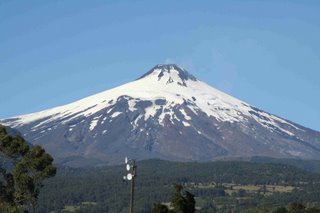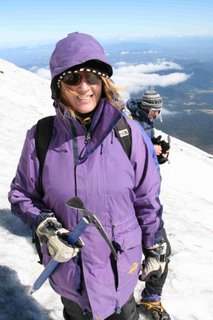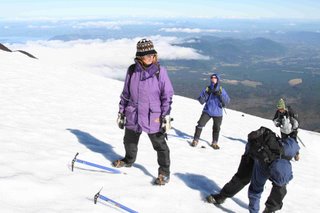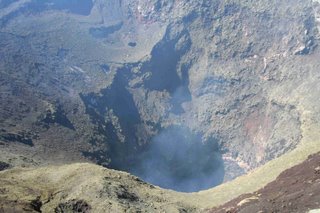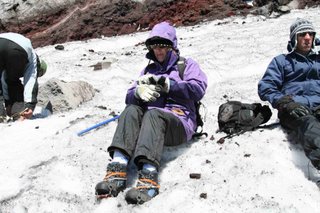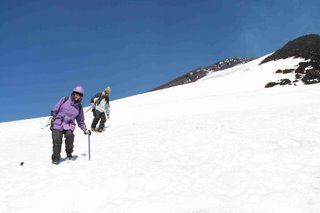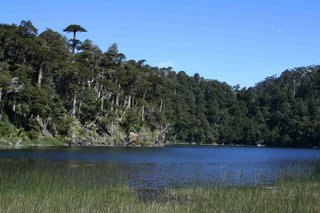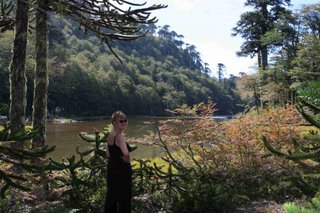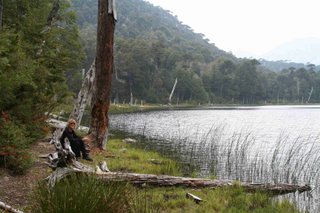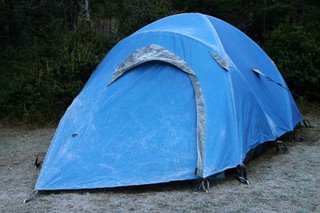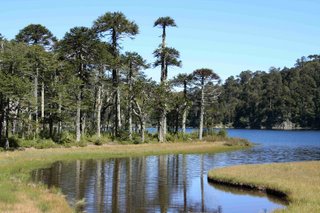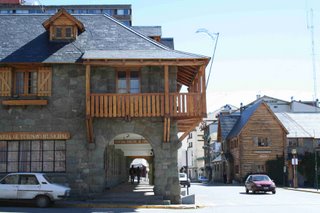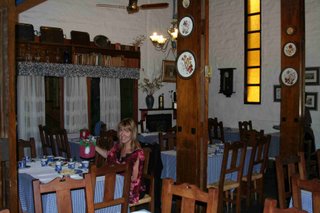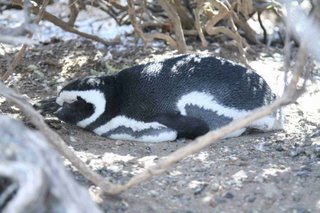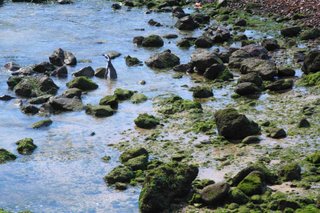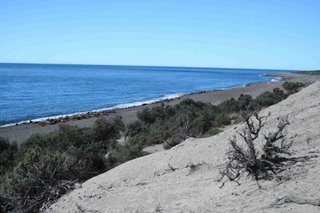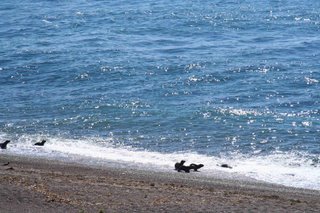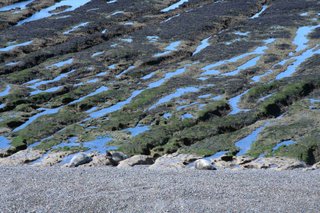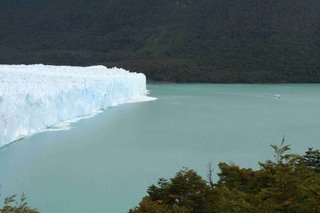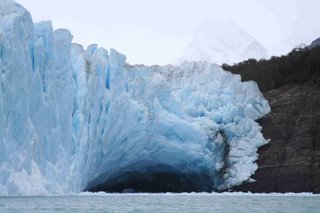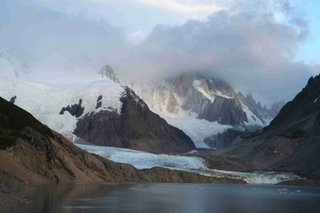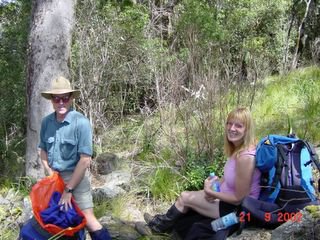Note: Click on the photos to see them full size.At 1,241m the John Garner pass is not particularly high nor is it overly steep. What makes the pass one of the more hazardous places we have visited this holiday is the battering it receives from gale force Westerly winds blasting off the Southern patagonian icecap just a few kilometres away. Combine the wind with the sudden changes in weather that can bring a snow storm even in the middle of summer and you will begin to understand why it is a place to move through quickly and only visit if well prepared to deal with extreme conditions, a place where you are thankful for modern high-tech materials to keep out the cold.
So it was with some alarm that we made a discovery the night before we took on The Pass.
"My boots are worn out and won´t grip anymore" Cheryl was explaining.
"Look at the soles... Uh that´s new, the soles are coming away from the uppers!"
"What´s the other one like?" I asked.
"Hmmm, the same, both of them have let go on the ball of the foot and the heel!"
Do you know that sick feeling you get when your computer crashes and you have not backed up what you have been working on all day? Well, that's how we were feeling about then. Here we were at a very windy, freezing cold and wet Los Perros campsite on the Grand Circuit of Torres del Paine and our options were few. We could walk back for three days and retrace what we had already covered, patch up the boots and take a punt that they will hold together across the pass or wait a day in the hope of better weather before pushing on.
The Grand Circuit of Torres del Paine National Park is without a doubt one of the world's classic walks. Usually done in ten days / nine nights the circuit is 110-120km in length passing through alpine and forest terrain and visiting the best of patagonia's spectacular mountain, lake and glacier scenery. A shorter trek called the W covers the main features of the park in only five days and is very popular in the summer months but we wanted to experience the more remote Northern sector that can only be reached on the full circuit.
The circuit can be executed in a number of ways depending on where you start and finish. We had chosen to begin with a visit to the huge granite monoliths that give the park its name, the Torres (towers) del Paine. (Some argue that the word Paine comes from the Tehuelche language and means pale blue. Others say it is the name of an early Welsh climber.) The three towers are over 1,000m tall and dominate your first views of the park as you approach from the flat pampas country to the East. I had read about these towers for many years in rock climbing journals and mountaineering books and for me they were just as famous as those other man-made towers in Paris and Pisa. So despite a ridiculously heavy pack with 10 day´s food, I trudged up the valley of the Rio Ascensio with Cheryl and we made camp. Although it was 6pm, there was still plenty of light so we took off up the steep ascent from the camp but without packs it was less than an hour before we crested the lookout ridge and there they were in all their glory.
 Our first sight of the Towers from the bus as we approached the Park
Our first sight of the Towers from the bus as we approached the ParkPhotographs taken through a wide-angle lens do not convey the sheer size of these things. Although I had seen many photos of them in the past, I was still gob-smacked when I saw them in real life. And I now have twice the respect for the few elite rock climbers in the world who have climbed these monsters.
 Los Torres del Paine
Los Torres del PaineNext morning the alarm dragged me out of a deep sleep in time for a return to the lookout before sunrise when the towers glow in the orange light of dawn. But that day it was not to be. There was a pitter patter of rain on the tent, I rolled over and went back to sleep.
 Cheryl in the forest during the beautiful walk from Lake Dickson to Los Perros campsite
Cheryl in the forest during the beautiful walk from Lake Dickson to Los Perros campsiteAt Los Perros sleep was not so easy to come by, there were decisions to be made. We quickly dropped the option of turning back. Where was the sense of adventure in that? We had to at least attempt the pass before giving up.
I got down to the business of patching up Cheryl´s boots. We decided to reserve the cloth tape we were carrying for a quick repair in the pass if needed. I had a spare pair of laces for my boots and with one lace per boot and some fancy knot tying I managed to stop the soles of Cheryl´s boots from flapping in the breeze.
In the morning the weather was not promising with gusty wind and overcast sky but at least it was not raining. We waited around until 10am hoping for it to show signs of improvement. It didn´t!
Eventually we decided to just go for it. The first part of the trek to the pass was through forest and there we encountered the worst boggy ground of the whole circuit. We slowly picked our way through the squelsh on bits of wood that had been placed by others. It took us back to the Dusky trek in NZ when our dear friend Barry Cully sunk in mud up to his thighs.
It was getting on towards 2pm by the time we finally cleared the bogs. We looked back and who should we see behind us but Dave Goldman.
Dave is one of those Americans you occasionaly meet who do not fit the stereotype. He is quiet, considerate and an all round nice guy. His most common saying was "I don´t want to crowd your space." We had met on the bus to the park and had stayed at the same camp sites the first four nights so a bond had formed and we had already walked parts of the trail together.
Now that we had company, the track that ascended the open slopes ahead did not seem quite as threatening.
"It´s snowing" said Cheryl as we started off from a chocolate break.
 Cheryl makes her way up the John Garner pass with patches of snow on the ground and a glacier far below
Cheryl makes her way up the John Garner pass with patches of snow on the ground and a glacier far belowA very light snow/sleet was starting and the wind was picking up. Dave was in sight ahead respecting our space. We zipped up our outer layer and pushed on. A little higher we copped our first gusts that knocked us off balance. We looked like we had joined the Monty Python silly walk brigade. As the wind got worse Dave waited for us and we wobbled along together until we could actually see the rock cairn that marked the top of the pass about 500m ahead. Despite the sight of that cairn, our hopes faded as the snow started getting heavier and the wind became so strong that the snow it was pelting at us was stinging our faces and we had to really lean into it to take even a single step. To top it all off, the visibility was quickly reducing to a "white out".
The situation was becoming desperate. Cheryl could not walk at all, it took all her energy to lean on her walking poles and remain upright.
 All smiles just before the storm hit. The top of the pass is visible in the background, we could see the rock cairn that marked the top
All smiles just before the storm hit. The top of the pass is visible in the background, we could see the rock cairn that marked the topIt was time to retreat, at least to some lower rocks where we could get out of the direct line of the wind. Dave and I started down but Cheryl seemed unable to move. This looked like the first signs of hypothermia setting in, so I badgered her into motion and we started to inch down. It seemed like an eternity but was probably only ten minutes before we reached a rock outcrop out of the wind beside a flat section of track where I reckoned I could pitch my tent if need be. I was ready to do that and get Cheryl into a sleeping bag to warm her up. However, she was fine.
After we put on an extra layer for warmth, Dave noticed that the wind had eased a little and we could again see the cairn in the pass.
We took the opportunity we had been given and started up again. This time, although the wind was very strong, we were not getting peppered with snow and we made it all the way to the pass.
When you are in such a pass, the only thing to do is to get the hell out of it and down the other side. But what a view we beheld on John Garner Pass, the Southern Patagonian Ice Cap and extending from it the panorama of the Grey glacier, 17 kms long and 5-7 km wide sweeping across our field of vision. I was stunned when Cheryl admitted that the misery of the pass had been worth it to see that view.
 Dave and Cheryl crossing the pass, the Grey glacier visible below
Dave and Cheryl crossing the pass, the Grey glacier visible below
 The Southern Patagonian Icecap, Grey glacier and nasty clouds still hanging around after we crossed the pass
The Southern Patagonian Icecap, Grey glacier and nasty clouds still hanging around after we crossed the passOnce through the pass the Grand Circuit follows the sculptured ice of the Grey Glacier to Lake Grey where blue icebergs messmorise trekkers with their beauty. The latter days of the circuit visit the valley Frances and Los Cuernos the "Horns of Paine" unusual peaks of granite capped with shale.
 The Grey glacier meets Lage Grey in a wall of blue ice
The Grey glacier meets Lage Grey in a wall of blue ice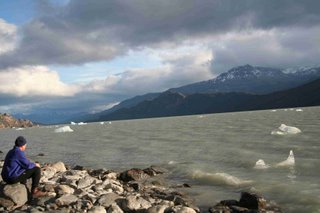 Laurie admiring the icebergs on Lake Grey
Laurie admiring the icebergs on Lake GreyDave went on to complete the full circuit. Cheryl´s boots with the shoe lace repair were still holding together after another four days and 50 kms. We made it as far as Campamento Italiano at the beginning of the Frances Valley where I was struck down with food poisoning from a bad packet of peanuts. I spent a day at that windy, dusty place, in and out of the tent with vomiting and severe diahorria. The following day we retraced our steps the two hours back to Lake Pehoe and took the boat out to the bus.
 Cheryl negotiating one of the steeper sections of scree
Cheryl negotiating one of the steeper sections of scree Icebergs on Lake Grey
Icebergs on Lake Grey
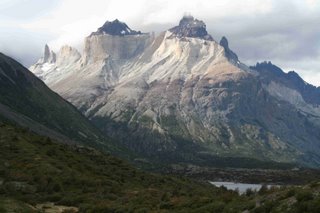 Los Cuernos
Los CuernosSo we have a little unfinished business at Torres de Paine. Now, if anyone wants a guide to show them around Patagonia next year Laurie and Cheryl Inc. may be available!
 Cheryl´s boots with the shoe lace repair
Cheryl´s boots with the shoe lace repair
